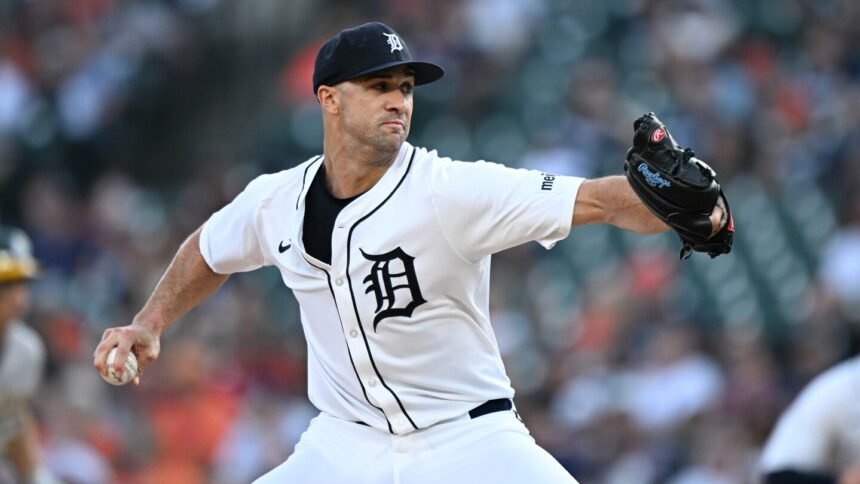It’s Wednesday, which means it’s time for us to visit the bump on Hump Day and discuss starting pitcher news. Each week in this article, I’ll be taking a deeper look at a few trending/surging starting pitchers to see what, if anything, is changing and whether or not we should be investing in this hot stretch.
The article will be similar to the series I ran for a few years called Mixing It Up (previously Pitchers With New Pitches and Should We Care?), where I broke down new pitches to see if there were truly meaningful additions that changed a pitcher’s outlook. Only now, I won’t just look at new pitches, I can also cover velocity bumps, new usage patterns, or new roles. However, the premise will remain the same: trying to determine if the recent results are connected to any meaningful changes that make them worth investing in or if they’re just mirages.
Each week, I’ll try to cover change for at least four starters and give my clear take on whether I would add them, trade for them, or invest fully in their success. Hopefully you’ll find it useful, so let’s get started.
Most of the charts you see below are courtesy of Kyle Bland over at Pitcher List. He created a great spring training app (which he’s now carried over into the regular season) that tracks changes in velocity, usage, and pitch movement. It also features a great strike zone plot, which allows you to see how the entire arsenal plays together. I’ll also use Alex Chamberlain’s awesome work with his Pitch Leaderboard.
Yusei Kikuchi – Los Angeles Angels
Earlier in the season, I wrote about Yusei Kikuchi’s confusing start to his tenure with the Angels, which included movement changes on his slider and a new arm slot. He wasn’t bad in the early going, posting a 3.06 ERA in his first 12 starts; however, that came with a 12.3% walk rate that led to a 1.52 WHIP and just 58 strikeouts in 64.2 innings. That made him borderline unusable in fantasy leagues despite the good ERA.
Then came this report from Jeff Fletcher at the beginning of June:
Something to watch tonight:
Yusei Kikuchi has seen his BB rate go up and K rate go down this year. Pitching coach Barry Enright told me they realized his grip on his slider and FB had changed from last year.
Will be interesting to see if going back to the old grip helps.
— Jeff Fletcher (@JeffFletcherOCR) June 3, 2025
In five starts in June, Kikuchi has posted a 2.25 ERA and 1.06 WHIP. He has seen his walk rate shrink down to 7.1% while his strikeout rate has exploded to 32.3%. So has it all just been the grip change on the slider and fastball?
The easy answer is no. Kikuchi’s fastball has been a bit harder in June with just 0.5 inches more Induced Vertical Break (iVB) and an almost identical vertical approach angle to May. His swinging strike rate (SwStr%) is down on the pitch in June, as is his CSW, and his barrel rate allowed is the highest it’s been at any point in the season. In truth, it seems like Kikuchi’s fastball has actually been worse after this tweet.
Similarly, as you can see from Alex Chamberlain’s Pitch Leaderboard below, Kikuchi’s slider hasn’t changed much in June either.
The vertical and horizontal movement is essentially the same as it was in May. The same goes for the velocity. The approach angles have shifted a little bit, but that might have more to do with Kikuchi raising his arm angle over two degrees in June. In fact, overall, Kikuchi has a 36-degree arm angle at release in June, which is up from 33 degrees in May. That’s notable because his arm angle was 42 degrees last year, so he had dropped it considerably at the start of the season and may be working to get it back closer to last year.
The biggest reason, in my opinion, for Kikuchi’s success has been his reliance on the curveball. He threw the pitch 9% of the time in May but is now up to 21% usage in June. In his five starts this month, the curve has a 16.8% SwStr% and 38.3% CSW with just a 23.8% Ideal Contact Rate (ICR). It has been, unquestionably, his best pitch. Over this stretch in June, he has used it just 7.2% of the time to lefties and 25.3% of the time to righties, which makes some sense since he’s throwing his slider to lefties nearly 53% of the time in June while posting a 19% SwStr%, so he doesn’t really need the curveball to lefties.
In June, Kikuchi is using the curve to righties both early in the count and late. It has a 66.7% early count usage but also a 29.3% two-strike usage. It’s early called strike rate of 27.3% is fine but just barely above-average; yet, it’s 31% PutAway Rate, which measures how often a two-strike pitch leads to a strikeout, is excellent. He has a solid 70% strike rate on the curve this month to righties, which means he’s either getting it over the plate early in the count for weak contact or having them chase off the plate in two-strike counts for swings and misses. This has been crucial for him because, on the season, his slider has just a 10% SwStr% to righties and only a slightly above-average PutAway Rate, so he has needed the curve to pick up the slack.
The curve has been his most-used early count pitch to righties in June, with the changeup being his second most-used early count pitch this month. Kikuchi has a 67% strike rate on the changeup to righties with a 16.4% SwStr% and 44% ICR, so going changeup/curve heavy early in the count to righties has helped and has also allowed him to save his four-seam fastball more for two-strike counts. In June, he used his four-seamer 38% of the time in two-strike counts to righties; however, it has just a 6.3% PutAway Rate, which is much lower than the 31% PutAway Rate it’s had to lefties this past month.
At the end of the day, this feels very similar to what Kikuchi did last year in the second half, but with him leaning on his curve this year instead of his slider. He has always been a streaky pitcher, so we know to use him during his hot streaks, but he doesn’t feel fundamentally different here. He’s using his slider aggressively against lefties and then turning to the four-seamer later in counts, and is using his curve and changeup early against righties while mixing in the four-seamer and slider later. It can work, and it has. But this doesn’t feel like a new Yusei Kikuchi.
Justin Wrobleski – Los Angeles Dodgers (New Arm Angle, New Cutter, Four-Seam Usage and Velocity)
If you look at Fangraph’s leaderboard for June, you’ll see Wrobleski among the leaders in SIERA. Over 26.1 innings in five appearances, Wrobleski has allowed eight earned runs on 22 hits with 26 strikeouts and six walks. That’s a 2.73 ERA with a 1.06 WHIP and 3.00 SIERA. I felt that was worth investigating.
Nick Pollack first put me onto some of Wrobleski’s changes during an episode of our “On the Corner” podcast. Nick’s first point was the increase in fastball velocity. The left-hander averaged 95.1 mph on his four-seam fastball, but that’s up to 96.6 mph over his five performances in June. That has also come with slightly more extension, but his 5.5-foot mark is well below league average with below-average raw movement. He does have a great Height Adjusted Vertical Approach Angle, which means that, from his release point, his four-seamer stays up more than most and almost seems to “rise” as it approaches the plate. That’s why it’s nice that he uses it 60% of the time in the upper-third of the strike zone. He does a better job of getting it up and inside to lefties than to righties, but that’s also to be expected.
Another big change, as you can see from Alex Chamberlain’s Pitch Leaderboard below, is that Wrobleski has lowered his arm angle almost five degrees from last season. That’s a pretty substantial difference.
The lower arm slot may have contributed to his increased extension and velocity, but we do know that it has likely impacted the change in his overall slider movement. Last year, he threw the pitch 87.4 mph with 2.6 inches of gloveside movement and 32.8 inches of drop, including gravity. This season, the pitch is slightly harder, with 3.2 inches of gloveside movement and nearly 35 inches of drop. As you’d expect, the lower arm slot has also altered the horizontal approach angle, which has led to far more groundballs and much weaker contact, in addition to a slight increase in swinging strike rate.
In June, he threw the slider 30% of the time to lefties and nearly 18% of the time to righties. Righties see it primarily as a two-strike offering, with a 47% usage rate in those counts, and the pitch has a solid 27% PutAway Rate. Lefties get the pitch in all counts, with a 58% early count rate and a 39% two-strike rate, but it has just an 8.3% PutAway Rate against lefties in June, which is not ideal.
That leads to the biggest issue with Wrobleski still. He has just a 6% SwStr% and 13.8% strikeout rate against lefties during this strong June run. He’s primarily slider/sinker to lefties and mixes in his four-seam and curve, but none of those miss a ton of bats. He could perhaps get more swings and misses if he turns to the four-seamer more in two-strike counts, but it remains to be seen if he will.
There has been marked improvement against righties this season. Some of that has to do with him getting rid of his sweeper and adding in a cutter. The cutter sits at 92.1 mph with just 1.2 inches of horizontal movement and 8.3 inches of “rise” if you were to remove the effects of gravity. In June, Wrobleski used the cutter 73% of the time early in the count against righties. The pitch has an 85% true first-pitch strike rate but also a 40% chase rate in two-strike counts when he does choose to use it. The pitch has a 14.5% SwStr% and 30.6% CSW against righties in June with a 36% ICR.
Using the cutter early in the count has set up the slider in two-strike counts, in addition to the four-seamer fastball, which he used 53% of the time in two-strike counts to righties in June. It also had a nearly 21% PutAway Rate, so that combination has been useful for him in two-strike situations.
Another development for Wrobleski has been a revamped changeup, which is almost three mph harder with nearly six inches more vertical movement, when accounting for gravity, and less armside movement. The pitch has a lower zone rate but a slightly higher swinging strike rate. It’s his fifth most-used pitch against righties, so it won’t make or break him, but it’s nice to see him possess such a deep arsenal against righties.
It’s unclear what role the Dodgers envision for Wrobleski, and I don’t love his profile against lefties, but if he’s going to stay in this piggyback role, he could be a useful option against right-handed-heavy lineups with a good chance of earning wins.
Mike Burrows – Pittsburgh Pirates (Arm Angle Change, Four-Seam Usage)
This is more of a full-on pitch mix analysis for Burrows, which was inspired by the fact that he’s 22nd in SIERA among all starting pitchers with at least 20 innings in June. In 26.1 innings last month, he had a 2.73 ERA, 1.22 WHIP, and 3.18 SIERA, with a 22% K-BB% that ranked 18th among that same leaderboard of starting pitchers. So is this something we can believe in?
Well, for starters, Burrow has a 95 mph four-seamer with 16.5 inches of iVB. It’s not a particularly flat fastball, so it doesn’t miss many bats, but he throws it in the zone often and doesn’t allow much hard contact. That’s a good start.
It is interesting to note that the graphic above shows that Burrows has lowered his arm angle quite significantly after his two appearances in May. It doesn’t seem to have done much to the overall shape of his pitches, but it has shifted the attack angle on his pitches. His slider and changeup, in particular, have lost some of their vertical attack in place of horizontal attack angle with that lower arm angle. What’s interesting is that both the slider and changeup are performing worse since the lower arm angle. The four-seamer is performing better, and that might be why he’s going to it more often, upping his usage by 11% overall.
In June, Burrows has gone to the four-seamer 45% of the time to righties while using the slider 34% of the time, the changeup 14% of the time, and the curve just over 7% of the time. The four-seamer is primarily his early count pitch, and we established that it’s a solid one. The slider has also been used 72% of the time early in counts to righties. Considering it has just a 39% zone rate and 57% strike rate, I don’t love him using it early in the count and would rather he use it late, considering it has a 33% PutAway Rate. However, I think that may have something to do with setting it up early. Overall, it’s a fairly mediocre pitch.
The changeup is better with a 12% SwStr% to righties in June, to go along with a 67% strike rate and a 44% ICR. He also uses it early in the count 63% of the time to righties but mixes it in 23.4% in two-strike counts, where it has a 31.4% chase rate and 37.3% PutAway Rate. Overall, it’s a really solid offering, but it’s not quite an ideal swing-and-miss pitch to righties, so Burrows is still missing that.
However, his approach of four-seam and changeup over 80% of the time to lefties is one I can get behind. The changeup gets plenty of called strikes early against lefties but can also miss bats with two strikes. His curve has been used mostly early in the count to lefties, but it has just a 15% zone rate and 26% strike rate to lefties in June. It also doesn’t miss many bats in two-strike counts, so it’s just a show-me third pitch.
At the end of the day, Burrows has a solid fastball and a good changeup that form a good foundation, but until he gets a two-strike whiff pitch and righties, he’s going to be limited to being used primarily as a streamer against teams who aren’t loaded with right-handed hitters who can hurt him.
Quinn Priester – Milwaukee Brewers
Back in April, I noted the changes that the Red Sox had made to Quinn Priester’s arsenal and how I thought it would lead to some Tobias Myers-type of success in Milwaukee.
⚾️Quinn Priester trade returned lots of value for Boston, but they revamped his arsenal and then shipped him off to succeed elsewhere. They added a cutter, tightened up his SL and narrowed the wide movement gaps. It has a real Tobias Myers feel for MIL.
— Eric Samulski (@SamskiNYC) April 17, 2025
It may have taken a bit of time, but Priester has been really good since the middle of May, posting a 2.42 ERA, 0.99 WHIP, and 38/7 K/BB ratio in 44.2 innings. While some of that has to do with matchups against Colorado, Pittsburgh, Baltimore, and Minnesota, he also faced the Cardinals, Braves, and Phillies, and that Reds matchup was in Cincinnati. So what else could be the cause of his recent success?
The first thing that stands out is that his cutter usage jumped back up in June, in addition to ticking back up in velocity. This was a new pitch that Boston added in the offseason, so it makes some sense that his usage of the pitch would fluctuate as the year went on. He has used the pitch just 13% of the time against righties during those last eight starts, but 27% of the time against lefties.
It’s not an elite pitch, registering just 91 mph with one inch of glove-side movement and more lift than the average cutter at that speed. However, he has tremendous control of the pitch, posting a 56% zone rate and 67% strike rate against lefties. He keeps it up in the zone often but doesn’t just bury it inside, with a 43% outside rate against lefites over this stretch. However, that has also led to plenty of groundballs but a little bit more hard contact than I’d like to see, with a 60% ICR against lefties.
Priester uses the cutter and sinker early in the count to lefties, which sets up a slider and curve as the two-strike offerings. He doesn’t throw the curve often, but it has a 15.2% usage against lefties over his last eight starts with a 20% SwStr% and 29% PutAway Rate. I think he might be able to turn to that pitch more often to get swings-and-misses against lefties.
However, that won’t help him against righties. He rarely throws the curve to righties, so he often relies on the slider and cutter in two-strike counts. The cutter has a 6% PutAway rate against righties over his last eight starts, and the slider is also below average with an 11.3% mark.
What the Brewers have done is narrow Priester’s arsenal, getting rid of the changeup, and trying to get him to focus more on the cutter, slider, and sinker working off of one another to keep hitters off the barrel and induce weak contact. As I said in my tweet above, this strikes me as a similar path to what they did with Tobias Myers, but with fewer pitches. I think that makes Priester a fine option in deeper formats, but he’s not going to miss enough bats to have huge fantasy appeal, and the high contact rates make him risky against good offenses.
Jack Flaherty – Detroit Tigers
The last three starts of June were not kind to Jack Flaherty, who allowed 18 earned runs on 16 hits in 13 innings with 12 walks and 15 strikeouts. That’s a 12.46 ERA, 2.15 WHIP, 22.4% strikeout rate, and 17.9% walk rate. Yikes! My first thought was to check and see if Flaherty was doing anything differently in June that might have led to this.
If you just look at pitch usage and shapes, not much stands out as being different. He’s leaned into his four-seam fastball more, but that has more to do with the lack of success of his breaking pitches (more on that later). We can see some difference in the shape of his curveball, which seems to have lost both vertical and horizontal break in June. Not much, but enough that it attracts our attention. The curve still had a 23.6% SwStr% in June, which is right in line with its usual numbers, and the barrel rate allowed was better than what the curve allowed in May.
Yet, that change in curve shape may be connected to another option, which Nick Pollack suggested during one of our podcasts, that Flaherty may have simply been tipping his pitches. I discussed this earlier this year with Shane Baz, and he has since had a solid run of production. During these last three starts when we saw the change in shape on Flaherty’s curve, the pitch had a 31% zone rate and 59% strike rate with a 50% swing rate against, an 87.5% zone contact rate, and an absurd 62.5% ICR. It still has a 22% SwStr%, but this is worth exploring.
On the season, Flaherty’s curve has a 30% zone rate and 60% strike rate with a 50% swing rate against, so those are basically the same numbers we’re seeing in this three-game stretch. However, for the year, the curve has a 74% zone contact rate allowed and a 38.6% ICR. So the curve was in the zone as often and swung at as often, but hit far more often and much harder. Huh. Was it locations?
Throughout the season, Flaherty’s curve has been 60% gloveside to righties and 86.4% LoLoc% (Low location, meaning the bottom third of the strike zone). He’s used it 48% of the time in two-strike counts to righties with a 31.6% PutAway Rate. Over this last three-game stretch, the PutAway Rate fell to 30%, so essentially the same, and he used it in two-strike counts just 36% of the time, but that may have just had to do with a lack of confidence. The pitch to righties was gloveside 68% of the time over that small sample and low 86% of the time, so the locations were pretty identical.
To lefties, Flaherty has used the curve armside 45% of the time and gloveside 34% of the time, while keeping it low 84.5%. He’s used it 52% of the time early in counts, and it has a 25% early called strike rate and 23% PutAway Rate. Over the last three-game stretch, the curve to lefies was armside 40% of the time and gloveside 33% of the time, while being low in the zone 77.5%. Perhaps you could argue that he hasn’t been burying the curve to lefties as much, but the rest of the location profile is similar. He’s still using it early in counts 57% of the time, with a 22% early called strike rate, and 21% PutAway Rate, so another instance where there doesn’t seem to be a huge change in location and usage.
All of that tells me that something was off with the curveball. Perhaps it was a minor change in shape. Perhaps hitters were able to spot something out of the hand and sit on the curve more effectively. However, nothing stands out to me as being a major red flag. The issue is just that Flaherty’s slider has been struggling a bit since the start of May, so he can’t afford his curve to get hit like this. Since May 3rd, Flaherty’s slider has a 11% SwStr%, which is well below the 13.8% MLB average for a slider. It also has a 37% zone rate, 58% strike rate, and 44% ICR. All of those are about 5% below average or more.
So if Flaherty’s slider has been mediocre for 10 starts, and his fastball is an average pitch to begin with, that puts a lot of pressure on his curve to carry him. I don’t think the curve is as bad as we’ve seen it recently, so I still think Flaherty can have some use as a streamer in good matchups, and I wouldn’t outright cut him. However, I don’t think you should feel that you need to hold Flaherty in shallower leagues if there are intriguing options on the wire.















